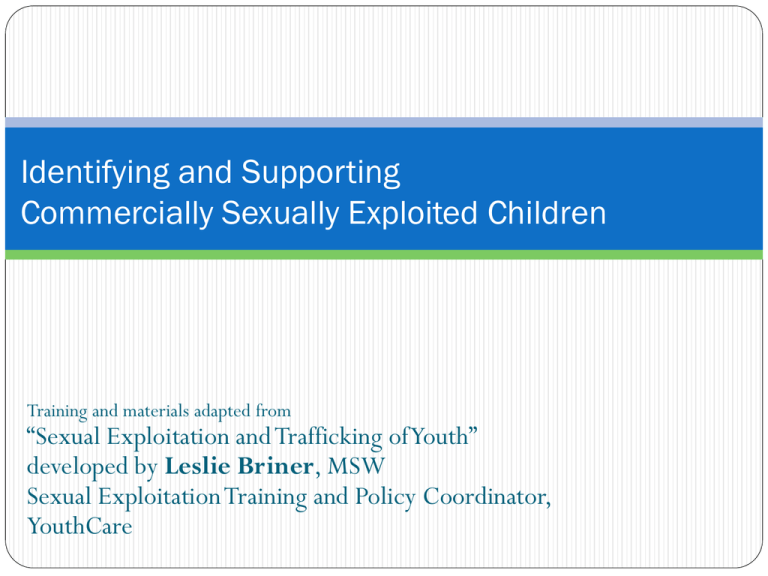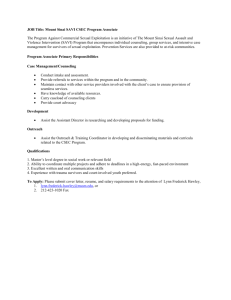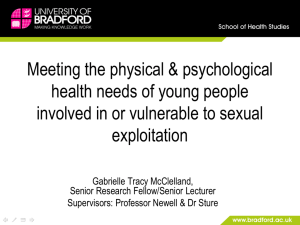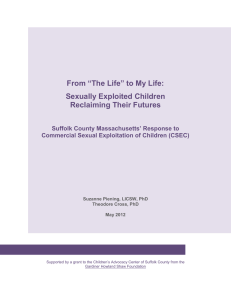
Identifying and Supporting
Commercially Sexually Exploited Children
Training and materials adapted from
“Sexual Exploitation and Trafficking of Youth”
developed by Leslie Briner, MSW
Sexual Exploitation Training and Policy Coordinator,
YouthCare
By the end of today you should..
Understand the basic dynamics of commercial sexual exploitation
of children and how experiencing commercial sexual exploitation
may impact a child/youth.
Be able to identify commercially sexually exploited children and
children who are at risk of being commercially sexually exploited.
Know policy and legal requirements when a child is identified as
being commercially sexually exploited or at risk of commercial
sexual exploitation.
Know resources in their community who are important to
effectively serving youth who have experienced Commercial
Sexual Exploitation.
Working Assumptions
Everybody has a right to speak and to be heard
We all do the best we can with the skills and
knowledge we have
This is both a process of learning and “un-learning”
The commercial sex trade is:
• A common social practice
• Predicated on systematic discrimination
• Inherently harmful for most people on the supply
side
• Perpetuated by the “demand” for commercial sex
Getting Started: 5 Lessons
1. Relationship IS the intervention
2. Address the subculture (prostitution, gangs, street life)
3. Re-frame the economic strategy
4. Develop partnerships and know your systems
5. This is the long game…
Digital Story - Sydney
Click here to watch Sydney's Story
Public Law 113–183, September 2014
‘‘Preventing Sex Trafficking and Strengthening Families Act’’
Child Welfare agencies must identify, document and assess
for services:
Any child we “have reasonable cause to believe” is a sex
trafficking victim
AND
Is in our care or for whom we have an open case
Report CSEC to law enforcement within 24 hours
Report total number of CSEC victims via AFCARS
Handout: Federal and State Laws related to CSEC
Can you identify the
Activity: Commercially Sexually Exploited
Children?
Prevalence: What’s your hunch?
Prevalence of child welfare system involvement
among children who have experienced commercial
sexual exploitation?
Other factors???
– how do you think gender identity,
race/ethnicity, socioeconomic status, sexual
orientation, immigration status impact the
individual’s risk?
Sexual Exploitation Affects:
All genders
Any economic class
Any race
Any education level
But…
…disproportionately affects young,
financially poor, youth of color, immigrant,
and LGBTQ youth.
Busting the Boy Myths
Content for this
slide compiled by
Norene Roberts,
MSSW
Myth: There are very few CSE boys.
Cultural context: women are victims, men are strong
Fear of being outed as gay or perceived as gay
May think service providers do not serve males even when they do
Not believed when they do come forward
Screening and outreach often targets only girls
Myth: Most CSE Boys identify as gay or bisexual.
Disproportionately high numbers CSE boys identify as sexual minorities. But
the majority of CSE boys identify as heterosexual.
Myth: Boys identify themselves as hustlers, choose to engage in the
sex trade and are not victimized in the same way that girls are.
Boys often experience extreme shame regarding their exploitation. This
sense of shame may lead boys to redefine themselves as “hustlers.”
Girls may have a similar experience, touting the money they make and the
lavish lifestyle they lead, and embracing terms like “ho” or “bottom bitch.”
Handout: CSEC Boys
Landscape of Exploitation
Pimps/3rd party trafficker
Gang-based
Family-based
“Survival Sex”
“Street family”
Self Promoting, Independent, “renegading”
Peer to peer
Exploitation through other forms of the sex trades
Handout: Contexts of Sexual Exploitation
The Making of a Girl
https://www.youtube.com/watch?v=9c2c2AsMZzY
Recruitment
• Lures: love, affection, money, safety,
protection and family
• Recruiters identify youth who are
vulnerable and targets for exploitation
Grooming
• Sexual abuse/assault, watching
pornography, sex with multiple people
• Create a fun new life where the youth is
part of a new family. Break down and
rebuild identity; street names
“Turning
Out”
• First sex act in exchange for
money/goods
• Critical moment. Most youth remember
how/when they were “turned out.”
Activity
What are the
impacts of
Commercial
Sexual
Exploitation
on Youth?
Handout: Impacts to Commercially Sexually
Exploited Children
Guilt, Shame and Stigma
“I am not worthy of love or
belonging”
and
“I can never be anything else”
Psychology of Trauma Bonding
Failure to self-identify to family, service providers or the authorities
Intense gratefulness for small favors when the offender holds life and death power over
the victim
Denial of the extent of violence and harm which the offender has inflicted or is
obviously capable of inflicting
Hyper-vigilance with respect to the offender’s needs and identification with offender’s
perspective on the world
Perception of those trying to assist in leaving “the life” as enemies and perception
of offender(s) as friends/trusted individuals
Extreme difficulty leaving one's offender/pimp, even after physical release has
occurred. Paradoxically, women in prostitution may feel that they owe their lives to pimps.
Going to extreme measures to protect or insulate the offender
Over time this leads to increased substance use and mental health issues
To Thrive:
connection and
healthy
relationships,
acceptance and
unconditional
regard, space to
redefine identity,
sex and love,
opportunity for
choices
What do these youth need?
Practical Needs:
mental health care,
education and
employment skills, legal
advocacy, transportation,
safety planning + case
management
Basic Needs:
safety, food, housing,
medical care
Overall Approach:
• Strengths Based
• Trauma
Informed
• Gender
responsive
• Culturally
responsive
Digital Story:
Keona
Click here to watch
Keona's story
Your Role:
Identify
Document
Determine
Appropriate Services
You are here
Identifying CSEC – Red Flags!
• Chronic truant/runaway/homeless/gang-involved youth
• Excess amount of cash
• Hotel room keys
• Having goods or services that they cannot pay for
• Lying about age/false identification; inconsistencies
• Dramatic personality changes, evasive behavior especially
around a “new boyfriend/girlfriend” or older group of
friends
• Carries multiple cell phones
Completing the CSEC Screen
Anytime there is a CSEC concern
about any child/youth of any age.
When a youth returns to care from
being on the run.
For children/youth 11 and older, at
first placement.
Activity part I
Complete the CSEC screen using the
information provided in your assigned
scenario
I suspect or have confirmed CSEC.
Now what?
1) Respond to immediate & critical needs (urgent medical,
mental health, other needs)
2) Make a report to intake
3) Make a report to Law Enforcement within 24 hours if
CSEC is identified.
4) Hold shared planning
meeting
5) Create a plan to support
youth and connect to
culturally appropriate
and specialized services
Getting Started: 5 Lessons
1. Relationship IS the intervention
2. Address the subculture (prostitution, gangs, street life)
3. Re-frame the economic strategy
4. Develop partnerships and know your systems
5. This is the long game…
Digital Story - Courtney
Click here to watch Courtney's Story
Asking the Youth
Sometimes people trade sex for
You ARE NOT required to ask.
You CAN + WILL work
effectively with youth who
don’t confirm CSE.
money or because they have to
survive, has that happened to you?
I’m wondering if you are in the life? I will not judge you or
anything you tell me. I’m here to listen if you ever want to talk or
want support getting out.
Has anyone ever forced you to do anything against your will?
What are your concerns, questions or fears about
initiating conversations with youth regarding
commercial sexual exploitation?
Optional Activity – No Strings Attached
Keys to Effective Engagement
Asking the question plants the seed!
Maintain a Compassionate and Non-judgmental
attitude.
Follow through on anything you say you will do.
Provide information relevant to the situation.
Avoid a “rescue” mentality
Identify their strongest healthy relationship
- AND/OR
Connect them to someone who can build the relationship
Digital Story - Nicole
Click here to watch Nicole's Story
Impact of Complex Trauma:
“I miss the drama…”
Hyper-arousal: Anger, panic,
nightmares, tantrums, phobias,
paranoia, increased heart rate,
adrenaline
Dissociation/Hypoarousal: Flat affect,
“numbing out”, inattention,
forgetfulness, pale skin,
low heart rate
Placement Considerations
Recruiting
Running away
Pregnant or
parenting
Information to
caregivers
Tricky Issues for Child Welfare
Monitoring violations of court orders. Who must report
these violations?
Who can consent to medical/mental health procedures?
Who can access these records & talk to those providers?
What about parents who still have rights?
How do we document CSE and also promote the youth’s
ability to move past CSE without the label following
them?
Handout: Legal Landscape for CSEC
Handout: Minor’s Health Care Rights Washington State
Who are our Partners?
Community Advocates
Juvenile Probation/Parole Counselors
Independent Living Providers
Law Enforcement – particularly victim’s advocates
MH and C/D providers who have worked successfully with
this population
Healthy & Supportive adults in the Youth’s life – incl.
placements and bio family
Handout: Statewide Service Responses and Resource List
Digital Story - Melody
Click here to watch Melody's Story




